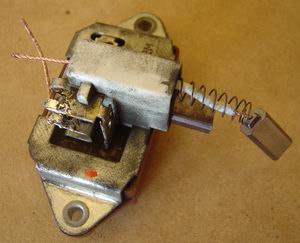I am King of Alternators. Okay, well, maybe not king but I have played with them _a lot_. I have sufficient understanding of them mechanically, electrically, and electronically that I could build you one from scratch if I had to. Anytime there is a problem that even slightly relates to a car charging circuit, I'm your man. Now with that said, here's a bit of humulity I'll grudgingly share with you...
The battery in the laser has gone flat. Hate that. Charge it up overnight, we're good (can't be bothered checking for a problem "maybe the battery is old and cannot hold a charge"). A day or two later, battery flat again. Must be the alternator.
Now Bosch alternators are the best alternators in the world. I looked down at the laser alternator and sure enough, its a Bosch alternator. Great! Means I don't even have to pull the alternator off the car or even slacken the belt.
(Because I'm so smart I immediately judge from the age of the the alternator that the brushes are spent - even though the charge light isn't coming up. Some brushes have a sprung plastic spike which is great - when the near the end of life "ping!" the plastic spike pops out and the alternator stops working, full stop. Without the plastic spike, towards the end of life it intermittently works - sometimes the brush is contacting, sometimes it's not flowing any power but the voltage is there, sometimes...well intermittent electrical failures are difficult to fault find, you just have to
know
;))
Top brush charred - not quite making a
decent contact on the slip ring anymore.
I have the brush pack (integral regulator) in my hand within two minutes, see the burnt brush, and head for my local auto parts store. I say "give me a set of brushes for this thanks mate" "Umm, I can give you the whole module, but not just the brushes." "C'arn mate, it's $2 for a set of brushes, the module works just fine."
Suffice to say I drive for about a hour but return with a $2 set of brushes. I pull out the soldering iron and bung them into place. Nothing sinister here, just remember which wire gets soldered where - and before you ask, no, they are all the same brush, you can put either one on either side... ;)

Solder the new ones in...
I throw it all back together and start the car up. I put my digital multimeter on the battery and give it a rev. What the...? 17 volts! That's way too much (14V tops, thanks). I shut it down, scratch my head. Pull out the brush pack and check for dry soldering joints, for strange resistances (maybe the module did pop?) Back in, 19V this time! Arghh, what is the problem?
After another hour of hair pulling, I say "I don't have time for this" and drive down the road and buy a new $40 module. I put that in and guess what...19V again! It is about this time I change multimeters - perhaps the multimeter is wrong. Next multimeter shows 17V again. I pick up the multimeter to shake it and behold and low...voltage drops to 14!
"YOU SCHNAPPER!" I think to myself. Being a digital multimeter, and sitting on the battery which is right next to the coil, it is picking high tension lead interference and showing the wrong voltage. I slap myself on the forehead, put my original new brush module back in, of course, measuring the voltage properly it is working fine.
So you see, when you think you are The King of something you are very quickly put in your place - a lesson in humility.








 database
database